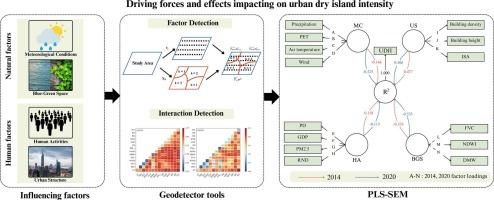南京大都市区干岛强度时空动态及影响因素
IF 7
2区 环境科学与生态学
Q1 ENVIRONMENTAL SCIENCES
引用次数: 0
摘要
随着自然环境的变化和人类活动的影响,城市干岛效应在全球范围内逐渐加剧,对城市居民的生活质量产生了很大的影响。基于南京市区54个气象站逐时相对湿度数据,分析了城市干岛强度(UDII)的时空特征,并利用Geodetector工具和偏最小二乘结构方程模型(PLS-SEM)分析了自然和人为因素对城市干岛强度(UDII)变化的影响。这项研究的结果揭示了以下几点。(1) 2014 - 2020年南京大都市区UDII呈波动下降趋势,且不同季节和昼夜差异明显,夜间和冬季UDII较强。UDII在城市中心最强,向城市外围逐渐减弱。(2)人为因素和自然因素对UDII的平均影响分别为0.42和0.31,表明人为因素对UDII的塑造作用更为突出。(3)城市结构(US)是加剧UDII的关键潜在变量,而蓝绿空间(BGS)具有一定的缓解作用,气象条件(MC)通过作用于蓝绿空间(BGS)间接加剧了UDII。(4)虽然气温和植被覆盖度等自然因子也有影响,但在高度城市化背景下,它们的影响受到人类的严重调节,这进一步凸显了人类在UDII中的主导作用。该研究为理解UDII提供了新的视角,为优化城市布局和改善城市环境提供了科学依据。本文章由计算机程序翻译,如有差异,请以英文原文为准。

Spatiotemporal dynamics and influencing factors of urban dry island intensity in Nanjing Metropolis, China
With changes in the natural environment and the influence of human activities, the urban dry island (UDI) effect has gradually intensified globally, which has a great impact on the quality of life of urban residents. In this study, we analyzed the spatial and temporal characteristics of the UDI effect based on hourly relative humidity data from 54 meteorological stations in Nanjing metropolis and analyzed the effects of natural and human factors on changes of urban dry island intensity (UDII) using Geodetector tools and partial least squares structural equation modeling (PLS-SEM). The results of this study revealed the following. (1) The UDII in Nanjing metropolis showed a fluctuating downward trend between 2014 and 2020, and there were obvious differences between different seasons and between day and night, with the UDII being stronger at night and in winter. The UDII is strongest in the city center and gradually weakens toward the city periphery. (2) The average effects of human and natural factors in UDII are 0.42 and 0.31, respectively, indicating that human influences play a more prominent role in shaping UDII. (3) Urban structure (US) is a key latent variable that exacerbates UDII, whereas blue–green space (BGS) has a mitigating effect to a certain extent, and meteorological conditions (MC) indirectly exacerbate UDII by acting on blue–green space (BGS). (4) Although natural factors, such as air temperature (AT) and the fraction of vegetation cover (FVC), are also influential, their effects have been heavily modulated by humans in the context of high urbanization, which further highlights the dominant role of humans in UDII. This study provides new perspectives for understanding UDII and a scientific basis for optimizing the urban layout and improving the urban environment.
求助全文
通过发布文献求助,成功后即可免费获取论文全文。
去求助
来源期刊

Ecological Indicators
环境科学-环境科学
CiteScore
11.80
自引率
8.70%
发文量
1163
审稿时长
78 days
期刊介绍:
The ultimate aim of Ecological Indicators is to integrate the monitoring and assessment of ecological and environmental indicators with management practices. The journal provides a forum for the discussion of the applied scientific development and review of traditional indicator approaches as well as for theoretical, modelling and quantitative applications such as index development. Research into the following areas will be published.
• All aspects of ecological and environmental indicators and indices.
• New indicators, and new approaches and methods for indicator development, testing and use.
• Development and modelling of indices, e.g. application of indicator suites across multiple scales and resources.
• Analysis and research of resource, system- and scale-specific indicators.
• Methods for integration of social and other valuation metrics for the production of scientifically rigorous and politically-relevant assessments using indicator-based monitoring and assessment programs.
• How research indicators can be transformed into direct application for management purposes.
• Broader assessment objectives and methods, e.g. biodiversity, biological integrity, and sustainability, through the use of indicators.
• Resource-specific indicators such as landscape, agroecosystems, forests, wetlands, etc.
 求助内容:
求助内容: 应助结果提醒方式:
应助结果提醒方式:


